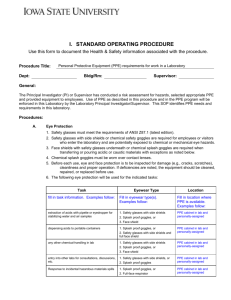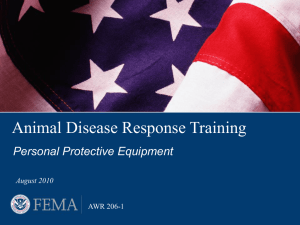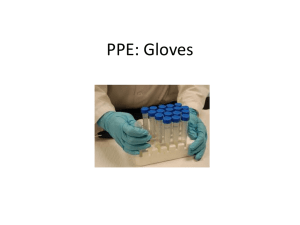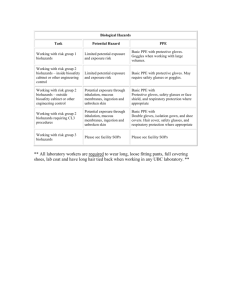Word - Department of Environmental Safety
advertisement
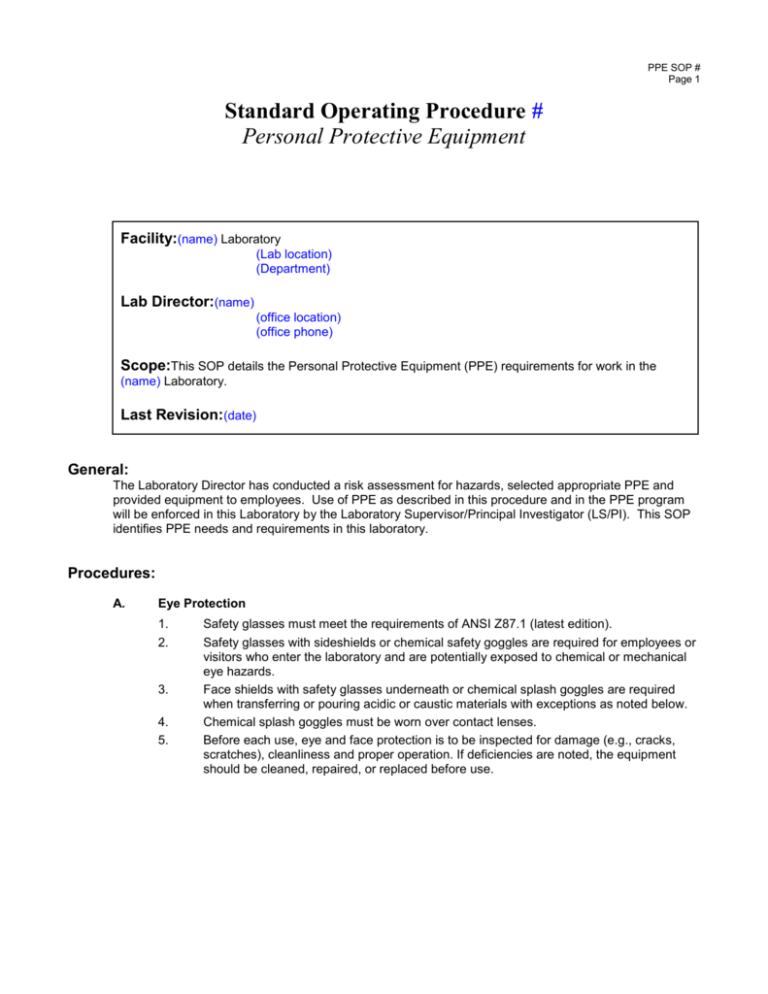
PPE SOP # Page 1 Standard Operating Procedure # Personal Protective Equipment Facility:(name) Laboratory (Lab location) (Department) Lab Director:(name) (office location) (office phone) Scope:This SOP details the Personal Protective Equipment (PPE) requirements for work in the (name) Laboratory. Last Revision:(date) General: The Laboratory Director has conducted a risk assessment for hazards, selected appropriate PPE and provided equipment to employees. Use of PPE as described in this procedure and in the PPE program will be enforced in this Laboratory by the Laboratory Supervisor/Principal Investigator (LS/PI). This SOP identifies PPE needs and requirements in this laboratory. Procedures: A. Eye Protection 1. 2. 3. 4. 5. Safety glasses must meet the requirements of ANSI Z87.1 (latest edition). Safety glasses with sideshields or chemical safety goggles are required for employees or visitors who enter the laboratory and are potentially exposed to chemical or mechanical eye hazards. Face shields with safety glasses underneath or chemical splash goggles are required when transferring or pouring acidic or caustic materials with exceptions as noted below. Chemical splash goggles must be worn over contact lenses. Before each use, eye and face protection is to be inspected for damage (e.g., cracks, scratches), cleanliness and proper operation. If deficiencies are noted, the equipment should be cleaned, repaired, or replaced before use. PPE SOP # Page 2 6. The following eye protection will be used for the indicated tasks: PPE SOP # Page 3 Task Task Eyewear Type Location fill in task information. Examples follow: Fill in eyewear type(s). Examples follow: Fill in location where PPE is available. Examples follow: extraction of acids with pipette or eyedropper for stabilizing water and air samples 1. Safety glasses with sideshields PPE cabinet in lab and personally-assigned 2. Splashproof goggles, or 3. Face shield dispensing acids to portable containers 1. Splashproof goggles, or 2. Safety glasses with sideshields and full face shield any other chemical-handling in lab 1. Safety glasses with sideshields 2. Splashproof goggles, or PPE cabinet in lab and personally-assigned PPE cabinet in lab and personally-assigned 3. Face shield entry into other labs for consultations, discussions, etc. 1. Safety glasses with sideshields, or Response to incidental hazardous materials spills 1. Splashproof goggles, or 2. Splashproof goggles 2. Full-face respirator B. PPE cabinet in lab and personally-assigned PPE cabinet in lab and personally-assigned Gloves 1. Chemical resistant gloves shall be worn whenever the potential for hazardous skin contact exists. The material safety data sheet for the substance or glove selection charts should be consulted to determine appropriate glove type/material. Glove selection resources will be consulted when employees are unsure what type of glove is necessary for protection against specific chemicals. DES maintains glove selection and MSDS resources on its website at: http://www.des.umd.edu/os/ppe/glove/index.html http://www.des.umd.edu/os/rtk/msds/index.html 2. Lab-specific standard operating procedures specify glove requirements for identified routine operations. 3. Gloves shall be removed before touching other surfaces (e.g., doorknobs, faucet handles, keyboards). 4. Heat resistant gloves shall be used for handling hot objects. Asbestos-containing gloves will not be used. 5. Abrasion resistant gloves (such as leather) should be worn for handling broken glass or for other potentially abrasive situations. They should NOT be used for handling chemicals. Gloves are not necessary if broken glass can be picked up with forceps, dustpan, etc. 6. Before each use, gloves are to be inspected for damage and contamination. If deficiencies are noted, the gloves should be cleaned, repaired, or replaced before use. 7. The following types of gloves will be used for the indicated tasks: Task fill in task information. Examples follow: Glove Type Fill in glove type(s). Examples follow: Location Fill in location where PPE is available. Examples follow: PPE SOP # Page 4 acidification of water & air samples 1. Two-mil nitrile, or PPE cabinet in lab 2. Neoprene, or 3. Viton entry into other labs for consultations, discussions, etc. Two-mil nitrile PPE cabinet in lab Response to incidental hazardous materials spills gloves compatible with spilled chemical (e.g., butyl, neoprene, Silvershield, Viton, natural rubber, nitrile, 4H, etc.) PPE cabinet in lab or as available in DES responder’s bag asbestos or lead bulk sampling Two-mil nitrile PPE cabinet in lab C. Footwear 1. No sandals or open-toed shoes are to be worn by employees entering UM lab facilities. Shoes should have nonskid soles and should have a reasonable heel height. 2. Safety shoes must be worn if there is potential for injury from heavy objects (e.g., handling drums, cylinders). The LS/PI is responsible for procuring safety shoes if they are determined necessary. 3. Safety shoes must meet the requirements of ANSI Z41 (latest issue). D. Clothing 1. Laboratory coats or other suitable work apparel shall be worn by laboratory employees whenever there is potential for chemical exposure in the work area. 2. Clothing must be cleaned regularly. If a spill occurs on the clothing, it must be decontaminated before reuse. Lab clothing should not be washed with other household clothing. 3. Disposable clothing should be considered when working with highly toxic materials, carcinogens, mutagens, or teratogens. The LS/PI is responsible for determining the need for disposable clothing. 4. Before each use, clothing is to be inspected for damage, deterioration, contamination. If deficiencies are noted, the clothing should be cleaned, repaired, or replaced before use. 5. Shorts will not be worn in the laboratory. 6. The following types of protective clothing will be used for the indicated tasks: Task E. Type Location fill in task information. Examples follow: Fill in glove type(s). Examples follow: Fill in location where PPE is available. Examples follow: asbestos or lead bulk sampling Tyvek disposable suit with attached hood and shoe coverings corner cabinet in lab entry into other labs for consultations, discussions, etc. lab coat coat hooks in lab Response to incidental hazardous materials spills Clothing compatible with spilled material and conditions of exposure. May include disposable Tyvek, poly-lined Tyvek corner cabinet in lab or ESF dry storage area handling any chemical materials in lab lab coat coat hooks in lab Hearing Protection 1. Hearing protection (earmuffs or plugs) is required whenever employees are exposed PPE SOP # Page 5 2. 3. 4. to noise levels of 85 decibels or greater as an 8-hour time weighted average (TWA). Industrial Hygiene workers exposed to noise levels in excess of 90 dBA will wear hearing protection regardless of the duration. Hearing protection is to be inspected before each use, for tears and contamination. If deficiencies are noted, the hearing protector should be cleaned, repaired, or replaced before use. Annual audiogram and other requirements of the UM Hearing Conservation Program apply if full-shift noise exposures are 85 decibels or greater. The Program is available at: http://www.des.umd.edu/os/hearing/manual/index.html The following types of hearing protection will be used for the indicated tasks: PPE SOP # Page 6 Task F. Type Location fill in task information. Examples follow: Fill in glove type(s). Examples follow: Fill in location where PPE is available. Examples follow: evacuation drills foam plugs or muffs PPE cabinet in lab or as available in DES responder’s bag assessment of possible high noise areas foam plugs or muffs PPE cabinet in lab or as available in DES responder’s bag Respirators 1. Respiratory protection is not required for any routine work conducted in the laboratory. 2. Industrial Hygiene staff that are responsible for assessing chemical spill sites must ensure that they and other DES responders have respirators capable of controlling the particular chemical species and concentration. Emergency conditions (i.e., airborne contaminants in excess of established Immediately Dangerous to Life and Health concentrations) are to be handled by Prince George’s County emergency response personnel. 3. All employees issued respirators for any reason must follow all the requirements set forth in the UM Respiratory Protection Program. The Program is available at: http://www.des.umd.edu/os/respirator/manual/index.html 4. The following types of respiratory protection will be used for the indicated tasks: Task Type Location fill in task information. Examples follow: Fill in glove type(s). Examples follow: Fill in location where PPE is available. Examples follow: obtaining bulk asbestos or lead samples half-face air-purifying respirator with P100 filters, or respirators are individually fitted and assigned. Additional filters are available on shelves in the lab. full-face air-purifying respirator with P100 filters, or full-face powered air-purifying respirator with P100 filters entering (asbestos) restricted areas or overseeing asbestos abatement activities in containment full-face powered air-purifying respirator with P100 filters respirators are individually fitted and assigned. Additional filters are available on shelves in the lab. incident response full-face air-purifying respirator with cartridges selected for specific contaminant, or respirators are individually fitted and assigned. Additional filters are available on shelves in the lab. full-face powered air-purifying respirator with cartridges selected for specific contaminant PPE SOP # Page 7 mold assessment N/R/P95, N/R/P99, or N/R/P100 disposable facepiece respirator, or half-face air-purifying respirator with P100 filters, or full-face air-purifying respirator with P100 filters, or respirators are individually fitted and assigned. Additional filters are available on shelves in the lab. full-face powered air-purifying respirator with P100 filters 5. Specific information concerning respirator capabilities, filter selection, IDLH concentrations, etc., is contained in the DES Respiratory Protection Program maintained by the IH Equipment Lab director. Training: 1. 2. 3. 4. Employees using PPE must be trained in proper selection, care and use. The LS/PI is responsible for providing training for protective eyewear, footwear, gloves and clothing. Users of respirators other than filtering facepiece models must be trained annually by the Department of Environmental Safety. Users of hearing protection who are exposed to full-shift average noise levels over 85 dBA must be trained annually by the Department of Environmental Safety. The LS/PI is responsible for ensuring that respiratory protection and hearing conservation training are provided when employees have a demonstrated need for entry into these programs.
